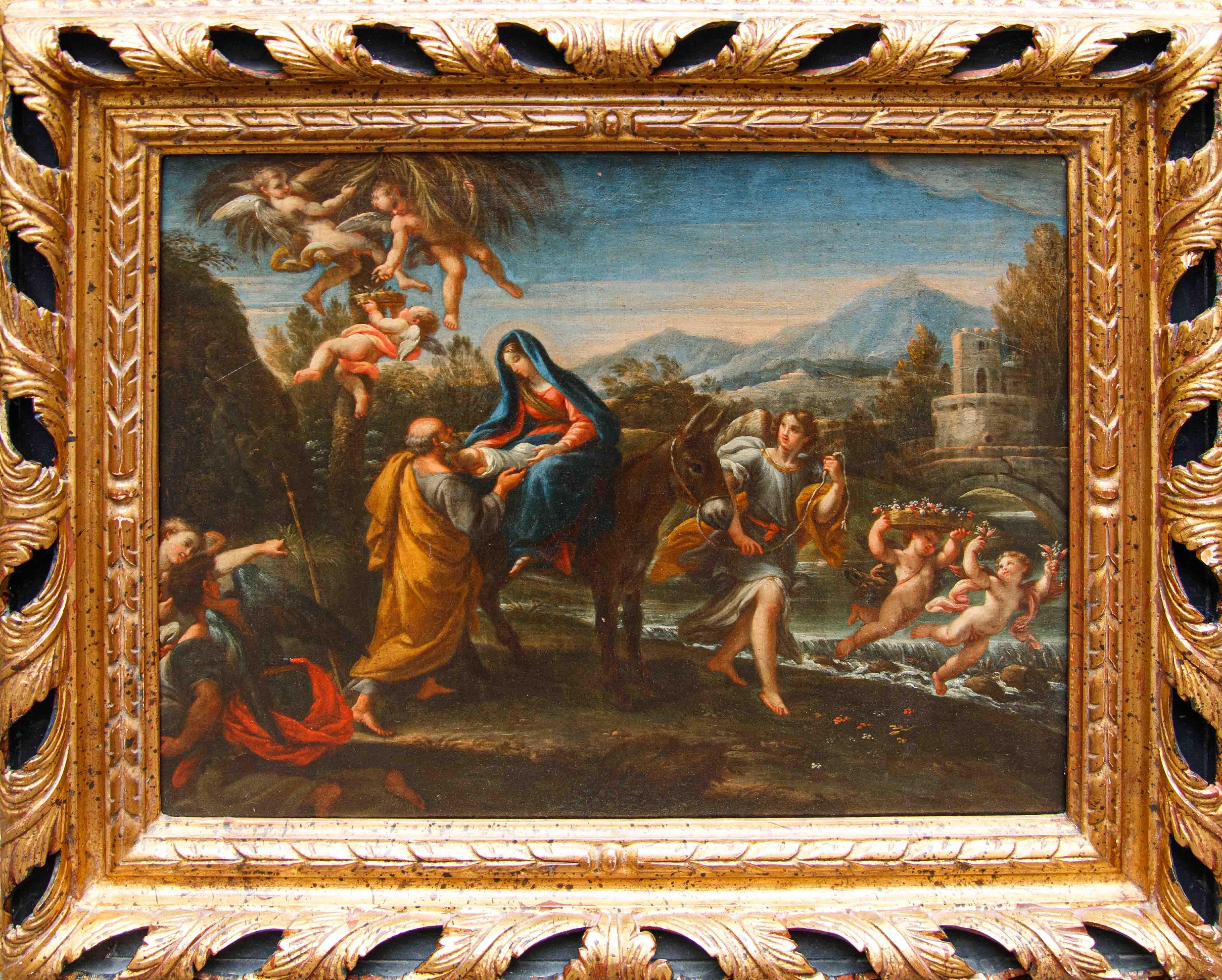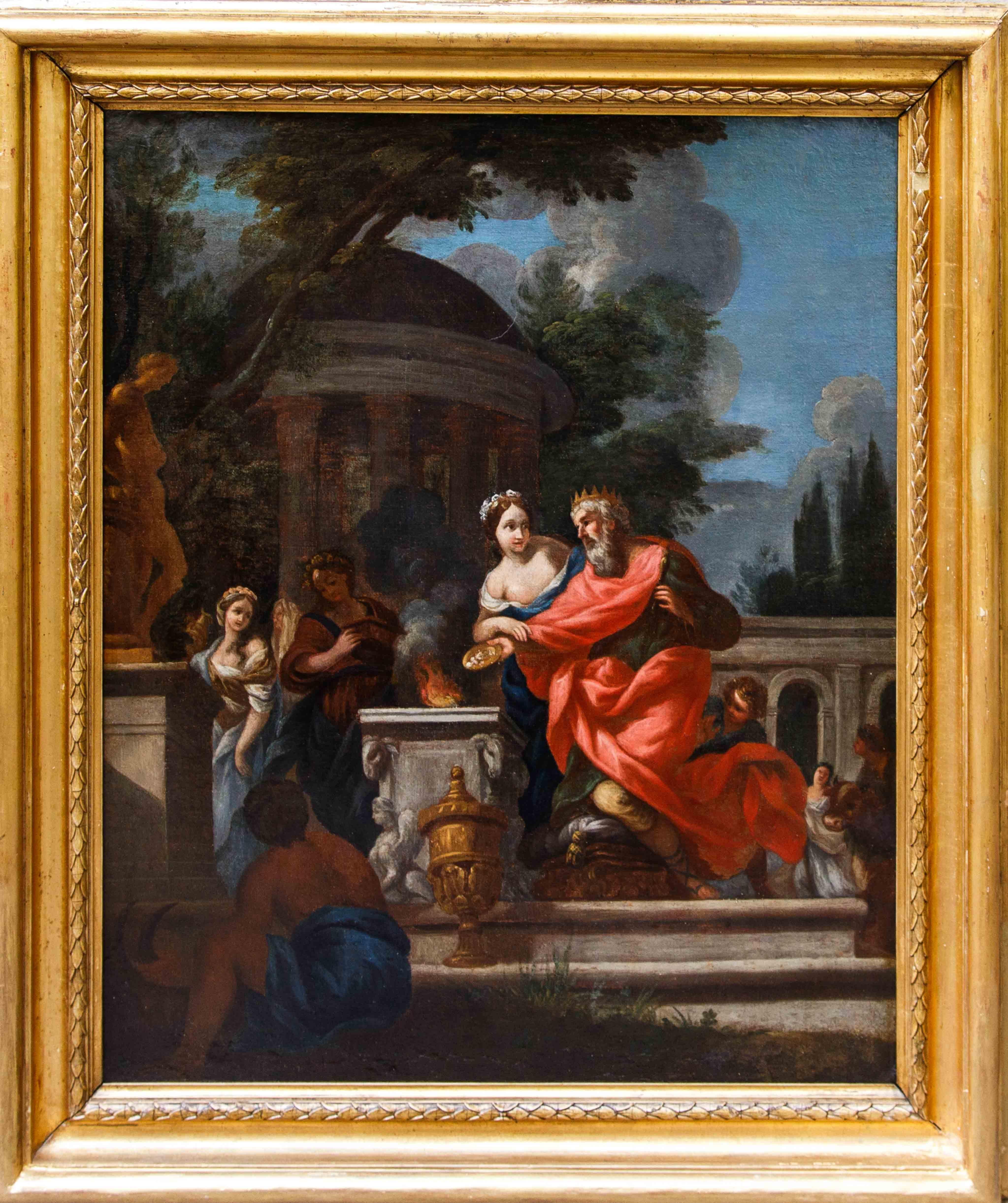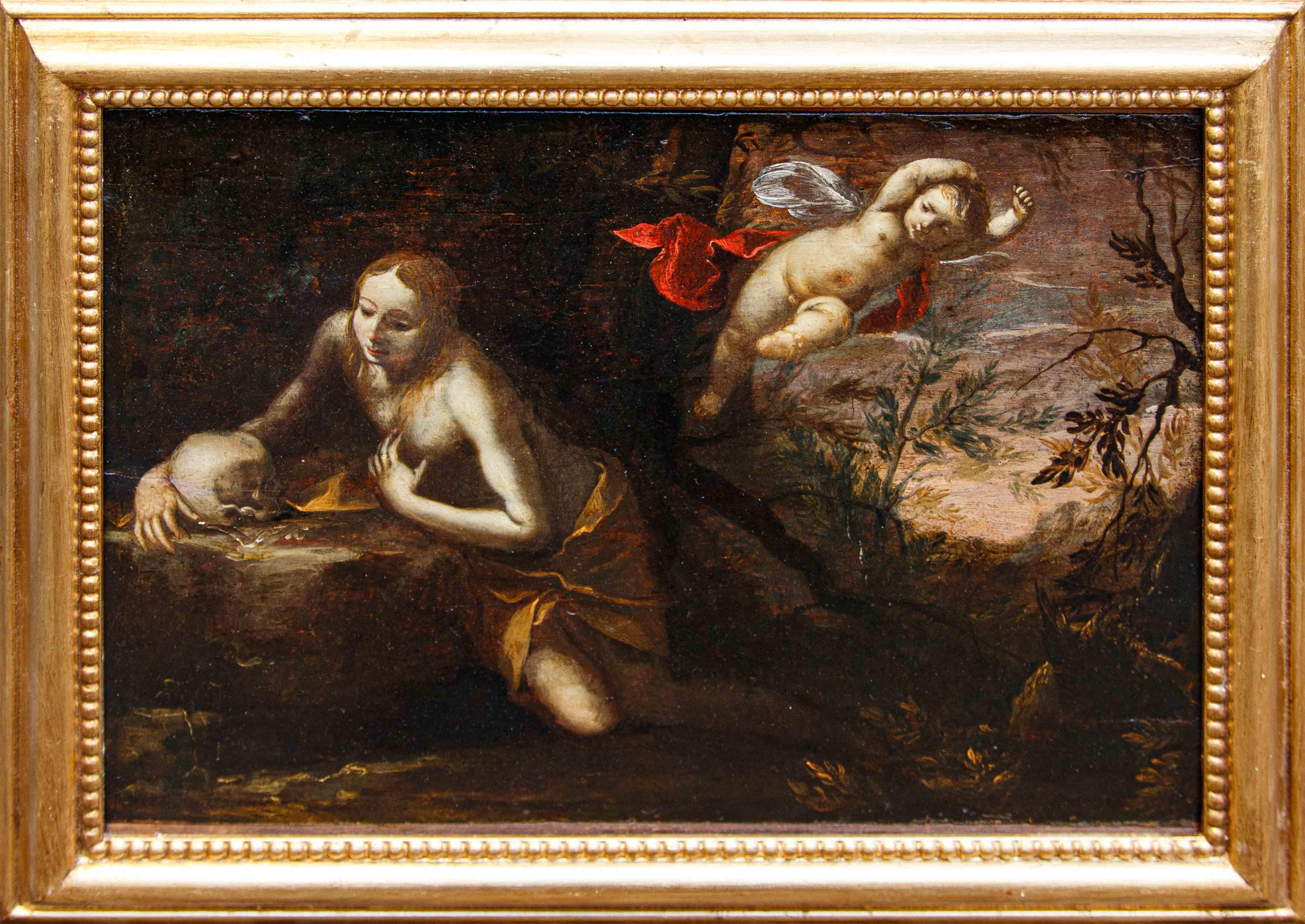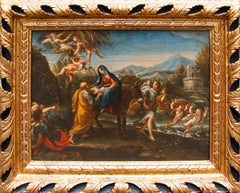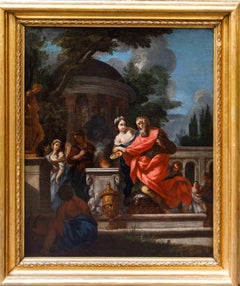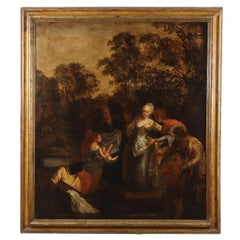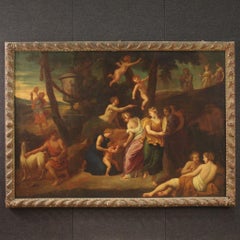Items Similar to Pietro Dandini (Florence, April 12, 1646 - November 26, 1712), The Finding
Want more images or videos?
Request additional images or videos from the seller
1 of 18
Pier (Pietro) DandiniPietro Dandini (Florence, April 12, 1646 - November 26, 1712), The Finding
$9,603.83
£7,047.01
€8,000
CA$13,086.04
A$14,739.30
CHF 7,632.95
MX$179,002.91
NOK 96,956.14
SEK 91,971.08
DKK 60,884.83
Shipping
Retrieving quote...The 1stDibs Promise:
Authenticity Guarantee,
Money-Back Guarantee,
24-Hour Cancellation
About the Item
Pietro Dandini (Florence, April 12, 1646 - November 26, 1712), attr.
The Finding of Moses
Oil on canvas, 105 x 206 cm
Framed, 116 x 219 cm
Born, as the erudite Baldinucci reports, in 1646 in Florence into a family of artists, Pietro (or Pier) Dandini received his first rudiments in painting from his uncle Vincenzo. News about his existential parabola is known to us through Francesco Saverio Baldinucci's very detailed biography of him, written within a few years of his death: the fact that, within a very limited period of time after his death, an independent biography was dedicated to him demonstrates the great critical fortune that the painter, already from the very early eighteenth century, enjoyed in Tuscan circles. Following his Florentine training, Dandini made a study sojourn in Venice, tangentially touching on the centers of Modena, Parma and Bologna as well: at this juncture, the Tuscan had the opportunity to observe live and carefully study the works of Titian, Veronese, Correggio and the Carraccis, which left an indelible mark on his branched visual imagination, markedly influencing his entire future production. In his early works, including Un Miracolo del beato Giovacchino Piccolomini-which the erudite Cinelli in 1677 praised highly- and the Assumption of the Virgin in St. Verdiana, one denotes a definite influence with respect to the production of Pietro da Cortona, perceived as an ideal master. Beginning in the 1790s, Dandini received important public commissions in Tuscany, often being hired by the grand duke himself: in 1591, for example, the artist frescoed an Allegory of Tuscany for the vault of the portrait hall of the Uffizi, a work warmly acclaimed by the now elderly arist Livio Mehus; other members of the grand ducal family availed themselves of Dandini on multiple occasions as decorator of their residences: grand Duchess Vittoria, at the Pitti Palace and at Poggio Imperiale, and Cardinal Francesco Maria at the villa of Lappeggi: here Dandini, in 1703, painted in fresco a ceiling with the Chariot of the Sun and six battle scenes of extreme quality that until the 1970s were considered to be by Borgognone (Rudolph,1972; Gregori, 1978). Given the rarity of this painter's paintings in public Italian and foreign collections, considerations inherent in his work can be drawn mainly from works in churches in Florence or other Tuscan localities. Prominent among the works certainly attributed to him is the altarpiece in S. Giovannino dei Cavalieri in Florence, with the Beheading of the Baptist, one of the masterpieces of second-century Florentine art. Although we learn from writings coeval with or slightly later than his existential parable that he also sent works to Germany and Poland (F. S. Baldinucci, p. 280; Moucke, 1762), he was undoubtedly operative especially locally, where he distinguished himself decisively and did not lack for commissions, not only because of his great talent but also because of the affable character that distinguished him and the literary and musical culture that procured him many distinguished friends.
The themes related to the infancy of Moses enjoyed great iconographic fortune in the 17th century, primarily because they discerned in them the foreshadowing of the Christological themes illustrated between the pages of the four canonical gospels and the apocryphal texts. For example, in the adventurous story of the finding of baby Moses by Pharaoh's daughter, we read the foreshadowing of the Escape to Egypt of the Holy Family, in which Jesus escapes from the persecution of the pagan king Herod. The finding of Moses was also often interpreted as symbolizing man's triumph over the adversities that threaten him and grip his troubled existence. On several occasions throughout his entire career, Dandini presents episodes from the life of Moses in his canvases: we need only think, in addition to the beautiful canvas in question, of Moses as a child tramples on Pharaoh's crown, currently at the Crociani picture gallery in Montepulciano. In this case, the Florentine artist depicts the scene of the child prophet being found: in a landscape reminiscent of the verdant territories of the Latium countryside furrowed by the Tiber River, a large group of female figures move about. In the foreground, a servant girl hurries to rescue from the waters of the river the baby's small body, abandoned in a wicker basket visible at her feet. The woman is about to hand the newborn child to the queen of Egypt, richly attired and with a crown - a typical attribute of Dandinian patrician women - on her head, who opens, in a gesture of extreme gentleness, her arms to receive him, amid the astonished eyes of the gynoecium crowding around her. Many of the crucial characteristics of Dandini's activity are discernible in the painting: the rapid, textural brushstrokes, the decisive, rosy tone of the complexions, the sinuous, strongly connoted features of the physiognomies of the faces, and the dense crowding of well-socialized figures within the compositions.
- Creator:Pier (Pietro) Dandini (1646 - 1712, Italian)
- Dimensions:Height: 41.34 in (105 cm)Width: 81.11 in (206 cm)
- More Editions & Sizes:106x205Price: $9,604
- Medium:
- Period:
- Condition:
- Gallery Location:Milan, IT
- Reference Number:1stDibs: LU2639216356742
About the Seller
No Reviews Yet
Vetted Professional Seller
Every seller passes strict standards for authenticity and reliability
1stDibs seller since 2023
Typical response time: <1 hour
- ShippingRetrieving quote...Shipping from: Milan, Italy
- Return Policy
Authenticity Guarantee
In the unlikely event there’s an issue with an item’s authenticity, contact us within 1 year for a full refund. DetailsMoney-Back Guarantee
If your item is not as described, is damaged in transit, or does not arrive, contact us within 7 days for a full refund. Details24-Hour Cancellation
You have a 24-hour grace period in which to reconsider your purchase, with no questions asked.Vetted Professional Sellers
Our world-class sellers must adhere to strict standards for service and quality, maintaining the integrity of our listings.Price-Match Guarantee
If you find that a seller listed the same item for a lower price elsewhere, we’ll match it.Trusted Global Delivery
Our best-in-class carrier network provides specialized shipping options worldwide, including custom delivery.More From This Seller
View AllCarlo Antonio Tavella (Milan, 1668 - Genoa, 1738), Arcadian Landscape
Located in Milan, IT
Carlo Antonio Tavella (Milan, 1668 - Genoa, 1738)
Arcadian landscape with shepherds and flock
Oil on canvas, 58 x 97 cm
Framed, 67 x 105 cm
The canvas under consideration is insc...
Category
18th Century and Earlier Other Art Style Figurative Paintings
Materials
Canvas, Oil
Stefano Pozzi (Rome, 1699 - 1768), attr., Rest from the Flight into Egypt
Located in Milan, IT
Stefano Pozzi (Rome, 1699 - 1768), attr.
Rest from the flight to Egypt
Oil on canvas, 49 x 63.5 cm
Framed, 69 x 85 cm
Category
18th Century Other Art Style Figurative Paintings
Materials
Canvas, Oil
XVII secolo, Bottega di Giovanni Francesco Romanelli, L’idolatria di Salomone
Located in Milan, IT
XVII secolo, Scuola romana
Bottega di Giovanni Francesco Romanelli, detto il Viterbese (Viterbo, 1610 c.a. –1662)
L’idolatria di Salomone
Olio su tela, cm 73,5 x 59,5
Il dipinto ...
Category
17th Century Other Art Style Landscape Paintings
Materials
Canvas, Oil
Assunzione della Vergine Dipinto di Giovanni Coli e Filippo Gherardi
Located in Milan, IT
Giovanni Coli (San Quirico, 1636 - Lucca, 1681), Filippo Gherardi (Lucca, 1643- 1704)
Assunzione della Vergine
Olio su tela, cm 95 x 70
Con cornice cm 111 x 85
La tela in esame è...
Category
17th Century Figurative Paintings
Materials
Canvas, Paint, Oil
Paolo De Matteis (Piano Vetrale 1662 - Naples 1728), attr., Dream of Joseph
By Paolo de Matteis
Located in Milan, IT
Paolo De Matteis (Piano Vetrale 1662 - Naples 1728), attr.
Joseph's Dream
Oil on canvas, 49 x 65 cm
Antique Roman frame known as "Maratta," of carved and gilded wood, 61 x 76 cm
...
Category
18th Century Other Art Style Figurative Paintings
Materials
Canvas, Oil
By Giovanni Stefano Danedi, known as Il Montalto
Located in Milan, IT
Giovanni Stefano Danedi, known as Montalto (Treviglio, 1612 - Milan, 1690)
Penitent magdalene
Oil on panel, 34 x 45 cm
Framed, 44 x 57 cm
Provenance: Giancarlo Sestieri Collecti...
Category
17th Century Other Art Style Figurative Paintings
Materials
Oil
You May Also Like
Painting Moses Saved from the Waters 18th century
Located in Milan, IT
Oil on Canvas.
The painting looks to the similar work by Paolo Veronese (1528-1588), dated around 1560-70 and now in the Prado Museum, from which our painting takes up the compositio...
Category
18th Century Other Art Style Figurative Paintings
Materials
Oil
Painting The Preaching of St. John the Baptist, 17th-18th century
Located in Milan, IT
Oil on Canvas. North Italian school of the 17th-18th centuries.
The large scene is filled with figures in ancient Eastern garb, set in a northern, richly vegetated landscape with mou...
Category
Late 17th Century Other Art Style Figurative Paintings
Materials
Oil
Bucolic Scene - Oil on Canvas Attributed to Michelangelo Ricciolini - 1705
By Michelangelo Ricciolini
Located in Roma, IT
Bucolic Scene is a majestic oil painting on canvas attributed to the painter Michelangelo Ricciolini.
Includes a frame: 142 x 173 cm.
Good conditions, except for little loss of color on the canvas.
The beautiful painting represents a bucolic scene where shepherds, women, and children are conversing in a resting moment. The scene is set in an open space, probably a wood.
Michelangelo Ricciolini (1654 – 1715) was an Italian painter of the Baroque period. He first studied in Rome under Angelo Canini; he then joined the large studio of Carlo Maratta. He painted various works in Rome, including the dome of Santa Rita...
Category
Early 1700s Figurative Paintings
Materials
Oil
17th Century Oil on Canvas Italian Antique Mythological Painting, 1670
Located in Vicoforte, IT
Antique Italian painting from the second half of the 17th century. Oil on canvas artwork of great pictorial quality depicting a mythological subject, infant Zeus and the goat Amalthe...
Category
1670s Figurative Paintings
Materials
Canvas, Oil
Italian Baroque religious figurative painting of the 17th century oil on canvas
Located in Florence, IT
Painted with gilt wood frame, 58 x 75 cm.
is the work of the painter couple Viviano Codazzi (Valsassina 1603-Rome 1670), who specialized as a quadraturist and landscape painter, and...
Category
1640s Baroque Interior Paintings
Materials
Canvas, Oil
Rococò French Painter - 18th century figure painting - Allegory of the Arts
Located in Varmo, IT
French Master (18th century) - Allegory of the Arts.
53 x 72 cm without frame, 63 x 83 cm with frame.
Ancient oil painting on canvas, in a gilded wooden frame (not signed).
Condi...
Category
Late 18th Century Rococo Landscape Paintings
Materials
Canvas, Oil
